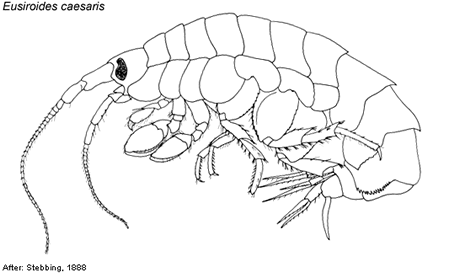 |
||||||
|
|
|
|
|
|
Australian Amphipoda: EusiridaeJ.K. Lowry, P.B Berents & R.T. Springthorpe
Eusiroides caesaris Stebbing Eusiroides caesaris Stebbing, 1888: 970, pl. 88. Eusiroides monoculoides. --Stebbing, 1906: 345 (in part). Eusiroides crassi. --Stebbing, 1910: 594.
not Eusiroides caesaris. --Walker, 1904: 264, pl. 4, fig. 22. Type material. HOLOTYPE, female, BMNH. Type locality. off Melbourne, Victoria, sand, 66 m depth (Challenger station 161). Description. Based on Stebbing, 1888: 970, pl. 88. Head rostrum present, short; eyes present, eyes reniform. Body dorsally carinate. Antenna 1 longer than antenna 2, or subequal in length to antenna 2; accessory flagellum present, accessory flagellum minute (1-articulate). Mandible molar columnar, triturative. Lower lip inner lobes present; outer lobes with narrow gap. Maxilla 1 inner plate apically setose. Maxilla 2 inner plate subequal or slightly broader than outer, or inner plate much broader than outer; inner plate slender medial setae few or absent, without oblique row of slender setae. Peraeon. Gnathopod 1 subchelate; subequal to gnathopod 2; coxa strongly produced anteroventrally; carpus not cantilevered, shorter than propodus, posterodistally lobed; propodus with robust setae along posterior margin (adults); dactylus narrowing distally, apically acute or subacute. Gnathopod 2 not sexually dimorphic. Gnathopod 2 subchelate; carpus not cantilevered, posterodistally lobed, shorter than propodus; propodus with robust setae along posterior margin (adults); dactylus narrowing distally, apically acute or subacute. Peraeopods 3-4 propodus simple, with distal slender setae (?). Peraeopods 5-7 dactyli inner margins smooth or minutely castellate. Pleon. Pleonites neither tricarinate. Epimeron 3 posteroventral margin serrate, corner subacute. Uropod 1 rami subequal in length. Uropod 3 peduncle without dorsal robust setae; rami subequal in length. Telson cleft, without large apical robust setae. Habitat. Marine; sand bottom. Depth zones. Continental shelf. Remarks. Stebbing (1906) synonymised E. caesaris with E. monoculoides Haswell (1879) and it has remained as such until now. J.L. Barnard (1974b) realised that E. caesaris should be considered as a separate species. He also considered that the E. monoculoides reported from New Zealand was most like E. pompeii. Because of the confusion surrounding species in this genus we are restricting our concept of E. caesaris and E. monoculoides to Australian waters. Distribution. Victoria: off Melbourne (Stebbing, 1888). Geographic areas. South-eastern Australia.
Cite this publication as: 'J.K. Lowry, P.B Berents & R.T. Springthorpe (2000 onwards). Australian Amphipoda: Eusiridae. Version: 2 October 2000. https://crustacea.net'. |
|
|
|
|
|
|
|
|
|
Copyright © Australian Museum, 2021
Australian Museum website

